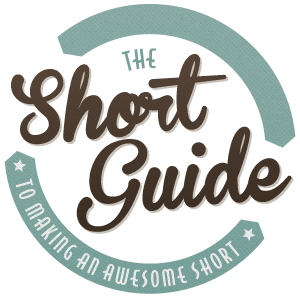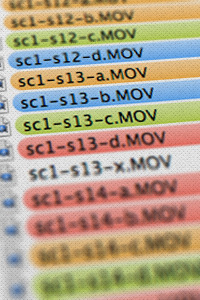
Part 1. Script Writing: Have a good story to tell
Part 2.1. Pre-Production: Be ready!
Part 2.2. Pre-Production: Keep on preparing!
Part 3. Production: Are you ready?
Part 4. Post Production: The fun part!
Part 5. Release and Promotion
Part 4: Post Production!
Finally my favorite part! After all that hard work you finally get to see something in front of you.
The day after you wrap on set can be an overwhelming one on your mind. So many ideas, so much excitement, where do you start?
Start by reviewing your shots
Make sure you covered everything and got every shot you needed. If you notice anything missing go back out there as soon as possible. After having a quick view of your shots, go back through them and rename all your files (if shot on digital DSLR), and try to keep them numbered with the same numbers on your storyboard, numbering the take last, i.e. sc01-sh02-03 (scene/shot/take). If your take is a definite outtake, or a that you pressed record my mistake for 10 seconds, mark it as -xx, but don’t delete it yet, you never know these might come in handy later.
 Now have a 3rd, attentive run, try to bring in the assistant director on this process. Carefully go over each shot and mark down comments for each, try color coding the files, i.e. best=green, good=yellow, not good but some things can be used=orange and completely unusable=red. Again don’t discard any yet, they might come in handy during editing.
Now have a 3rd, attentive run, try to bring in the assistant director on this process. Carefully go over each shot and mark down comments for each, try color coding the files, i.e. best=green, good=yellow, not good but some things can be used=orange and completely unusable=red. Again don’t discard any yet, they might come in handy during editing.
You should probably use Final Cut Pro or Adobe Premiere to edit your film, these can be complex softwares if you don’t know how to use them, but with some time and dedication anyone can learn, at least the basics. If you are not an editor, try finding one that would be willing to help you, editing is a very important process of filmmaking that can change the tone of the movie completely if done wrong, or for better if done right.
However, you should consider using iMovie (or any other basic movie making software) to make a rough draft. Especially in cases where the film needs to go through vigorous special effects, a rough draft will help you, along with sound editors and musicians to get a close enough feeling of the final flow. In my case with ‘After The Rain‘, the rough draft helped greatly with the voice over recording sessions.
Music

Dealing with musicians can be tricky, some musicians want visuals to start composing, and some editors want music to start editing. This could also depend on the type of film you are creating, a film like Kiddo with a soft background sound might not need to be edited to the music, but a upbeat short like Red Riding who depends much on the music for build ups can benefit from editing to beat. In any way, music is a process that you need to think about in pre-production, at this point you should already have it in your hands or its in late production.
Editing
I am not here to give you an editing class, there are plenty of tutorials that can tell you so much more than I can. However my few important tips would be to edit your film in High Definition, the files might be much heavier, but if you want your quality work to be noticed make sure to work with the highest qualities, and then compress the files from there. See this guide as a good example for configurations.

Don’t get attached to all your shots
A lot of directors do the mistake of putting all their shots in the final film, which make the movie usually long and boring. Your making a short, you want your film to be snappy and dynamic, losing someone’s attention for one second could mean losing your viewer. So don’t be afraid to trim the edges of your shots, even though you might like the actor’s smile at the end of the shot, if it means nothing to the plot, remove it. The same thing with entire scenes, if it’s not a necessary element to the story, even if it’s a nice shot, removing can help the flow of your film.

Also don’t be afraid the move the story around, I know you’ve been working around this script for a while, and until now you’ve been convinced that its the perfect story. But things sometimes don’t turn out as you fully imagined them, and the film does not flow as you wished, so it could be best to cut complete scenes out even if they alter the story of the film. When you do this try to step out of your director’s boots and watch it as a spectator. One thing you’ll need to understand is that viewers will not see that deleted scene, therefore will not know that alternate, or “full” story. Your story might be better with that extra scene, but the finished movie might be better without it. In short films sometimes less is more.
All this to say do not get attached to your shots and story, don’t be afraid to cut, chop or move scenes around for a better flow, it might be difficult at first, but your audience will only see the benefits of it.
Keep transitions simple
Keeping your film dynamic means staying away from cheesy star-wipe fades, in fact don’t use any template fades or effects in the software. If you have any effects make sure to create them in After Effects, but don’t over use effects just because you can.
Intro and credits
This is usually a very underestimated part of filmmaking. You have to be careful with this, especially online, since the first thing people will see in your film is the opening titles, and if you lose their attention with bad graphics or sub-average titles you will lose them as viewers.

Like I’ve said in pre-production, if you have no experience in graphic design or visual design, find an artist that is willing to help. If you are stuck (if your film is awesome up to now you shouldn’t have trouble finding someone) and finding a designer is not an option, keep things simple! Avoid any typical and overused fonts like Times Roman, Comic Sans, Impact and even Inkburrow, in fact this guide pretty clearly explains why some fonts should not be used. If your gonna do any movements or fades, keep them simple and don’t go searching photoshop or your editing software for cool effects. Keep it subtle, slow movements, no more that 20% zoom, with a simple fade. If that’s too simple, use a blur to give it a bit more life, and you can use a simple overlay of a shot from your movie or anything else to give your font a moving texture.

Audio mixing is also of an extreme importance. Capturing good sound is very difficult if your not an expert at it, which means that your audio will probably have lots of background noise. Try to have a sound designer mix the final audio for you, if one is not available follow basic tutorials of your used software on how to remove background noise. Make sure all your voices are at the same level throughout the film, having fluctuations can be very frustrating to viewers, in fact we decline several films a week only because of the audio. So make sure your audio sounds professional, if you don’t know how get some professional help.
When Are You Done?
At some point you have to say “Ok, I’m done!”. Maybe the words a director has the hardest time finding, because you know… we’re all perfectionists! Go with your gut feeling, and your timeline. If there is no deadline for your film why not push it a little to make it even better, but be careful, pushing it too much might get people uninterested. In the end you just need to make sure your flow works well, and everything is the best you can make it with the tools you have. A good idea can be to have a small pre-release screening to a group of friends (preferably a group of movie enthusiasts) and maybe even to a select filmmaking society, show them a password protected version, and listen to their comments, they might see things you haven’t noticed.
Then go back, make any final adjustments and were ready for the big release!

